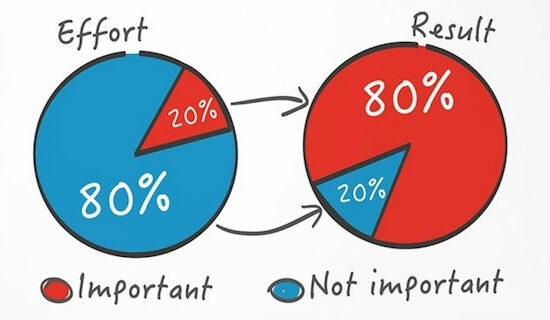
The Pareto Principle: 80% of our results coming from 20% of our inputs
“When we act less, we think more. And we think better. Most valuable creative ideas come to us when we are not hyper-busy or stressed, but in a calmer, more contemplative and receptive frame of mind”
This comes from a piece by Anna Katharina Schaffner Ph.D. in Psychology Today that reviews and reflects on “The 80/20 Principle: Achieve More with Less” by Richard Koch, who takes the Pareto Principle of 80% of our results coming from 20% of our inputs, something seen to be widely applicable in many areas of life, and then applies it to how we could use this in our personal lives in some quite radical ways.
One thing in Dr Schaffner’s piece popped out for me strongly in the way I have designed my life:
Koch is truly radical when it comes to time. Most of us feel short of time, as though the day does not have enough hours. We feel that there is always too much on our to-do lists and simply not enough time in the day to get through them. Koch argues the exact opposite: we are awash with time, and profligate in its abuse. We have more than enough time. Our true problem is simply that we do not use it well.
We should, he suggests, radically eliminate all low-value activities. If we can identify the 20% of our activities that matter – in whatever sphere – we can focus on just that and let go of the 80% of unproductive activities. As a consequence, we will suddenly have much more leisure and thinking time available to us: “If we double our time on our top 20 percent of activities, we can work a two-day week and achieve 60 percent more than now.”
That sentence in bold type is how I have designed my work and life over the last few years. I work with a limited number of clients at a time, with client “contact time” consciously limited to no more than 25% of my week. As the first quote notes, this leaves space for me to “think more and think better”, and to also be in of an optimally calm and receptive mind when focussing on my clients, including on deeply listening to them.
That 25% of my week equates to around 12 hours per week. Now imagine the diary of the average leader with all of their many responsibilities, tasks, emails, travel, administration, commuting and other travel etc. Can they create space to have as much as half of that time (6 hours) per week to meet with people when they are of “an optimally calm and receptive mind”? I would say that 6 hours per week of this type of work would be a lofty target for most business leaders to achieve so, by focusing on this as my “top activity” I can be more productive by doing more of that and radically eliminating all else.
So, when I say I am “always active, never busy”, this is by conscious design. I would say my mind is on “work” at least 50 hours per week, it is simply that by focussing on my “20%”, I am, as Robert Koch, says, “awash with time”, and, with that time, I am not “profligate in its abuse”, but conscious in how I invest my time.
Now, a caveat to all I have written before. I do fully recognise that there are multiple reasons why I can do this. High on this list is that I am an empty nester (all my children are adults and have “flown the nest” and thriving”) and that I have no caring responsibilities (again, all parents continue to thrive). As Dr Schaffner puts it: “Most of us are not completely autonomous masters of our time. We may have children, partners, dependents, and mortgages we must pay; we may work for other people or institutions who dictate our to-do lists and force us to spend our time in unproductive ways. We may also work in teams and be constantly dependent on other people’s input.”
So, with all I have noted using Koch’s thinking, my own example, and the caveats that may apply to you, what could you do, over time, to design your own “Pareto Life”?
As you consider that, please do read Dr Schaffner’s piece, as she refers to applying the 80:20 principle to other areas, so that may well be of value to you in thinking not only how you can free up time by applying Koch’s ideas around work, but also where you might choose to spend the time you may then free up.
